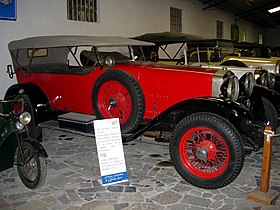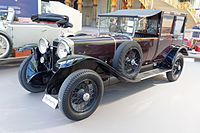Alfa Romeo RL
| Alfa Romeo RL | |
|---|---|
 Alfa Romeo RLSS (1925) with Lucas body from Barcelona[1] | |
| Overview | |
| Manufacturer | Alfa Romeo |
| Production | 1922–1927 |
| Assembly | Portello, Milan, Italy |
| Designer | Giuseppe Merosi |
| Body and chassis | |
| Layout | Front-engine, rear-wheel drive |
| Related | Alfa Romeo RM |
| Powertrain | |
| Engine |
|
| Transmission | 4-speed manual[2] |
| Dimensions | |
| Wheelbase | |
| Length | 4,630 mm (182.3 in) Zagato 4,450 mm (175.2 in) Castagna |
| Width | 1,770 mm (69.7 in) Zagato 1,870 mm (73.6 in) Castagna |
| Height | 1,650 mm (65.0 in) Zagato 1,630 mm (64.2 in) Castagna |
| Kerb weight | 1,550 kg (3,417 lb) Zagato 1,600 kg (3,527 lb) Castagna |
| Chronology | |
| Predecessor | Alfa Romeo G1 |
| Successor | Alfa Romeo 6C 1500 |
The Alfa Romeo RL was produced between 1922 and 1927. It was Alfa's first sport model after World War I, designed in 1921 by Giuseppe Merosi. It had a straight-6 engine with overhead valves, and came in three different versions: Normale, Turismo and Sport. A total of 2,640 RLs were made.
Models
[edit]The RLTF (Targa Florio) was the race version of the RL. It weighed half as much as the standard production models, despite the engine having seven main bearings instead of four and double carburetors. It was used among the 1923 Alfa race team, which had drivers like Ugo Sivocci, Antonio Ascari, Giulio Masetti and Enzo Ferrari. Sivocci's car had a green cloverleaf symbol on a white background; when he won the 1923 Targa Florio, that symbol was to become the Alfa team's good luck token. Five[6][circular reference] different RLSS were entered in the first Mille Miglia in 1927, but only two completed the race.
A 1925 RLSS version with rare, original bodywork by Thornton Engineering Company in Bradford, UK, is on permanent display in the Targa Florio exhibit at the Simeone Foundation Automotive Museum in Philadelphia, PA, USA. It is one of only 9 RLSS still in existence.[7]
| Model | Engine displacement | Max power | Years produced |
|---|---|---|---|
| RL Normale | 2916 cc | 56 PS (41 kW; 55 hp) | (1922–1925) |
| RL Turismo | 2996 cc | 61 PS (45 kW; 60 hp) | (1925–1927) |
| RL Sport | 2996 cc | 71 PS (52 kW; 70 hp) | (1922–1927) |
| RL Super Sport | 2996 cc | 71 PS (52 kW; 70 hp) | (1922–1927) |
| RL Super Sport Castagna | 84 PS (62 kW; 83 hp) | ||
| RL Super Sport Zagato | 89 PS (65 kW; 88 hp) | ||
| RL Targa Florio | 3154 cc | 95 PS (70 kW; 94 hp) | (1923) |
| RL Targa Florio | 2994 cc | 90 PS (66 kW; 89 hp) | (1924) |
| RL Targa Florio | 3620 cc | 125 PS (92 kW; 123 hp) | (1924) |
-
Alfa Romeo RL Targa Florio 1923
-
Alfa Romeo RL Targa Florio 1924
-
Short video clip of 1924 RL Targa Florio
-
Alfa Romeo RL Super Sport with Castagna brushed aluminium body, ex Sir Sultan Mohammed Shah Aga Khan 3 car.
-
Alfa Romeo RL Normale Limousine de Ville s/n 7946
Production numbers
[edit]| Year | 1922 | 1923 | 1924 | 1925 | 1926 | 1927 | Total | |
|---|---|---|---|---|---|---|---|---|
| Series | I, II | III, IV | V | VI | VII | I–VII | ||
| RL Normale | 3 | 610 | 443 | 259 | 1,315 | |||
| RL Turismo | 195 | 126 | 66 | 387 | ||||
| RL Sport | 3 | 215 | 176 | 143 | 537 | |||
| RL Super Sport | 304 | 12 | 76 | 392 | ||||
| Total | 6 | 825 | 619 | 901 | 138 | 142 | 2,631 | |
References
[edit]Notes
[edit]- ^ "Alfa Romeo en Auto Retro: Alfa Romeo RL SuperSport (1925)". bitacora.kcslot.com. Retrieved 2011-12-17.
- ^ "Search results for "Alfa"". carfolio.com. Retrieved 2008-01-04.
- ^ Fusi (1978), p. 57, 65.
- ^ Fusi (1978), p. 67.
- ^ Fusi (1978), p. 76, 77.
- ^ fr:Mille Miglia 1927
- ^ Simeone, Frederick. "1925 Alfa Romeo RLSS". Simeone Foundation Automotive Museum. Retrieved 11 March 2015.
- ^ Borgeson (1990).
- ^ Fusi (1978), p. 850.
Bibliography
[edit]- Borgeson, Griffith (1990). The Alfa Romeo Tradition. City: Haynes (Foulis) Publishing Group Ltd. Somerset, UK. ISBN 0-85429-875-4.
- Fusi, Luigi (1978). Alfa Romeo—Tutte le vetture dal 1910—All cars from 1910 (3rd ed.). Milan: Emmeti Grafica editrice.




